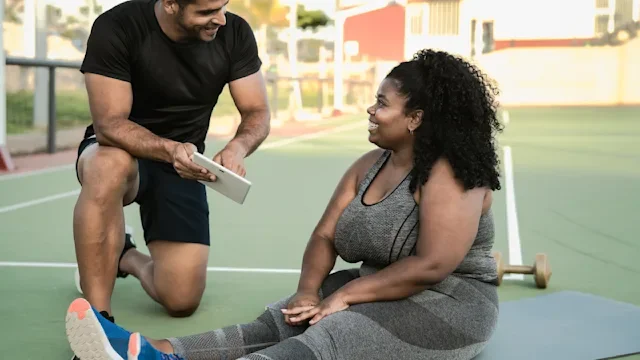Key takeaways:
Exercise can be safe and beneficial if you have heart failure.
Talk to your cardiologist before starting a new exercise program with heart failure. Your cardiologist or an exercise professional can help you create a safe, personalized plan.
Start slowly, and choose low-impact exercises you enjoy. Always listen to your body, and take breaks when needed.
When you have heart failure, your heart has to work harder to pump blood to the rest of your body. This can cause fluid to build up in your body, leading to symptoms such as shortness of breath or swelling in your legs and belly. So it's understandable to be concerned about exercising and overworking your heart.
In the past, experts advised people with heart failure to avoid physical activity. But exercise is now recognized as a great way to manage heart failure symptoms and improve well-being.
Still, it's important to approach exercise safely and under the guidance of a healthcare professional. With the right plan, you can enjoy the many advantages of exercising with heart failure.
Search and compare options
Is it safe to exercise with heart failure?
According to experts, exercise is safe –– and beneficial –– for most people with heart failure. It can help:
Improve circulation and oxygen delivery to the body
Help control blood pressure and cholesterol
Boost energy for daily activities
Reduce hospital visits for heart failure
Improve quality of life
But the best exercise plan may vary based on your heart failure type and severity.
A review of studies found that supervised exercise can be safe for people with stable heart failure with preserved ejection fraction (HFpEF). This common type of heart failure occurs when the heart isn't able to push enough blood forward because the muscle is stiff and doesn't relax as it should.
Another type of heart failure occurs when the heart muscle is weak and can't pump as much blood as it should. This is called heart failure with reduced ejection fraction, or HFrEF. A large study found that it was safe for people with HFrEF to engage in physical activity, and they tolerated exercise well.
Cardiac rehabilitation is a supervised exercise program for people with heart conditions. Find out what to expect during cardiac rehab.
Heart failure can be reversed in some cases. But nonreversible types often still respond to treatment. Here's what you need to know.
Is carvedilol the best beta blocker for heart failure? A cardiologist weighs in.
Tips for exercising with heart failure
Ready to get moving? The following safety tips for exercising with heart failure can help you get started.
Read more like this
Explore these related articles, suggested for readers like you.
1. Talk to your cardiologist
Consult your cardiologist before starting any exercise program. They can advise you on what types of exercise are safe and how much you should do. In some cases, you may need to undergo tests first.
Your cardiologist might suggest that you join a cardiac rehabilitation program. This is a special exercise program for people with heart problems. During cardiac rehabilitation, healthcare professionals monitor your blood pressure, heart rate, and response to exercise. Then, they'll recommend an exercise plan for you to follow at home. Don't forget to check with your cardiologist first if you want to add new activities or change your exercise routine.
2. Create an exercise plan that works for you
Everyone is different, so create an exercise plan that fits your needs and abilities. Consider your fitness level and any physical limitations you have. Fatigue is a common symptom of heart failure. If you usually have more energy when you wake up, try to exercise in the morning. And take breaks when you need them.
The American Heart Association (AHA) recommends that adults do the following exercises weekly.
Aerobic exercise: 150 minutes of moderate cardio, such as walking or cycling, or 75 minutes of vigorous cardio, such as jogging or dancing
Strength training: Muscle-strengthening activities, such as using resistance bands or lifting light weights at least two times
It's best to spread your workouts out over the week. Try to work up to exercising five days a week.
And remember to be flexible as you figure out what works best for you. There are lots of ways to meet your exercise goals. For example, if 30-minute workouts are too hard, try doing shorter, 5- to 10-minute workouts throughout the day.
3. Focus on low-impact exercises
Low-impact exercise allows you to move your body without putting too much stress on your bones, muscles, and joints. It's a great option for people with heart failure. Examples include:
Cycling on a stationary bike
Mind-body exercises, including tai chi and yoga, are also low-impact. Both can improve balance, flexibility, and relaxation while providing a gentle workout.
But you'll want to avoid certain exercises with heart failure. These include activities that involve:
Holding your breath
Heavy lifting
Working against your total body weight, such as push-ups or planks
These types of exercises can put extra stress on your heart. You should also avoid exercising in very hot or cold temperatures.
4. Start slowly, and gradually increase intensity
Ease into exercising with heart failure. There are many ways to add more physical activity to your routine. For example, try standing up and moving around during TV commercial breaks. Or, go for a walk at a comfortable pace for about 10 to 15 minutes per day.
You'll know you're working at a moderate intensity if your breathing is a bit heavy, but you can still talk to someone. Each day, try adding a few more minutes to your walking time as you can. If you start getting too short of breath, slow down.
Gradually work your way up to walking 30 to 40 minutes per day on most days of the week. As you become more comfortable with exercising, you can slowly increase the intensity of your workouts. Be patient; it might take a few months to reach your best level of exercise tolerance.
5. Always warm up and cool down
Warming up before exercise and cooling down afterward are important for everyone, but especially for people with heart failure. Warming up helps prepare your body for activity by slowly raising your heart rate, which also helps reduce stress on your heart. You can warm up by doing gentle movements and dynamic stretches for about 5 minutes.
When you're done exercising, take a few minutes to cool down by slowing down your exercise. For example, if you did a walking workout, you could start your cooldown by slowing your pace. Then, wrap up with some static stretches. Cooling down allows your heart rate and breathing to return to normal gradually. It also helps prevent dizziness or fainting, which can happen if you stop exercising suddenly.
6. Find activities you enjoy
Exercise is easier to stick with if you're doing something fun. Consider adding a variety of low-impact exercises to your routine to find out what you like.
You can try different activities depending on the day or season to keep things interesting. For example, you might enjoy light gardening in the spring. When you choose activities you enjoy, you're more likely to make exercise a regular part of your lifestyle.
7. Listen to your body
Pay attention to how you feel during and after exercise. Don't push yourself too hard. It's better to do a little bit consistently than to overdo it, get discouraged and abandon your fitness routine. Additionally, always follow your cardiologist's dietary recommendations and take all medicines as prescribed.
There are times when you should stop exercising and call your cardiologist. These include when you:
Feel more short of breath than usual
Are very tired
Feel dizzy or lightheaded
Have nausea or vomiting
If you develop chest pain while exercising, stop and call 911 immediately.
8. Set goals and track your progress
Having goals is another way to stay motivated. For example, your goal may be to have more energy to play with your kids or grandkids. Then, break it down into smaller steps. Your short-term goal might be to attend a low-impact water aerobics class once a week for two months to build muscle strength and endurance.
Use a fitness tracker or exercise journal to help you stay on track. These tools can help you see how far you've come and celebrate your progress, even if it seems small at first. Every step counts, and each improvement should make you proud.
9. Find an exercise buddy
Working out with others can make exercise more fun and keep you committed. Ask a friend or family member to be your exercise partner. They can help you stay accountable, and you can encourage each other. A dog can also be a great walking buddy.
Another option is to look for exercise programs in your community, such as walking clubs or fitness classes designed for people with heart failure.
The bottom line
Exercise can be a great tool for improving your well-being, even if you have heart failure. But it's important to know how to get moving safely and in a heart-healthy way. Your cardiologist or an exercise professional can help you create an exercise plan that's right for you. They can also tell you which exercises to avoid and what warning signs to watch out for while exercising with heart failure.
It's best to start slowly and gradually increase your exercise time and intensity. Choose workouts you enjoy, and listen to your body. If you develop symptoms that you’re doing too much, stop the activity and notify your cardiologist.

Why trust our experts?



References
American Heart Association. (2024). American Heart Association recommendations for physical activity in adults and kids.
American Heart Association. (2024). Warm up, cool down.
Cattadori, G., et al. (2018). Exercise and heart failure: An update. ESC Heart Failure.
Centers for Disease Control and Prevention. (2022). Measuring physical activity intensity.
Evans, R. A. (2011). Developing the model of pulmonary rehabilitation for chronic heart failure. Chronic Respiratory Disease.
MedlinePlus. (2022). Being active when you have heart disease.
Morris, J. H., et al. (2019). Exercise training and heart failure: A review of the literature. Cardiac Failure Review.
Moxley, E. (2021). Physical activity, exercise training and heart failure: Does intensity matter? Preventive Cardiovascular Nurses Association.
O'Connor, C. M., et al. (2009). Efficacy and safety of exercise training in patients with chronic heart failure: HF-ACTION randomized controlled trial. JAMA.
Pelliccia, A., et al. (2021). 2020 ESC Guidelines on sports cardiology and exercise in patients with cardiovascular disease. European Heart Journal.
Sachdev, V., et al. (2023). Supervised exercise training for chronic heart failure with preserved ejection fraction: A scientific statement from the American Heart Association and American College of Cardiology. Circulation.















